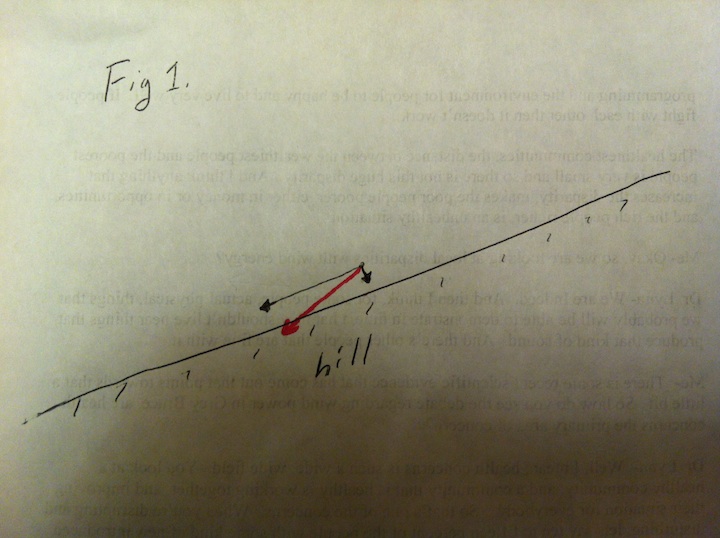Until recently, I’ve had a tendency to “late kick” while diagonal striding. This bad habit is observable in many skiers while they rollerski, and regrettably often leads to trouble skiing on actual skis on-snow. Here I will outline what late kick is, why it leads to poor form on snow, and some possible strategies to fix it.
To begin understanding what late kick is we first need to discuss the fundamental difference between classic rollerskis and classic skis with respect to how they get “grip”. A typical classic rollerski gets grip with a ratchet system inside the front or rear wheel that allows rolling forward but stops the wheel from rolling backwards. When you kick off a rollerski the wheel is always 100% locked (unless the ratchet is broken) and as long as the rubber is on the pavement you essentially will always have 100% “perfect” grip.
Classic skis, alternately, function by having a grip wax, klister, hairy, or fish scale pocket in the center of the ski that grips when compressed onto the snow. Because we don’t want to be gripped to the snow all the time, classic skis have built in camber, which keeps grip wax (or the other ways skis get grip I mentioned earlier) off the snow while the skiers’ weight is balanced between both skis, but allows it to grip when the skier compresses the camber of one ski with a quick weight transfer. This weight transfer combined with an alternating down, back, and (finally) up leg push is called a “kick”. On classic skis a good quality kick that is powerful and utilizes the balanced weight of the upper body is essential for getting grip, especially for skiing up steeper pitches.
Alternately, classic rollerskis do not need weight transfer to initiate grip, but since we want to be good skiers not rollerskiers then we need to rollerski the same way we want to ski.
Late kick can be best described as a kick that keeps rollerski wheels on the pavement too long, so that by the time the wheels do lift off the skiers weight is no longer transmitted downwards into the ski. A rollerskier with late kick will feel a momentary ease of motion at the end of their kick as the force of their body pushes the ski directly backwards and their hips sink down and back relative to their shoulders (which are often hunched over to compensate somewhat).
For those inclined to the language of physics, one could describe the component vectors (essentially force with a direction) of the force at the end of their kick being primarily one big arrow going backwards, and one tiny (weak) arrow pointing down towards the ground (black arrows). The resultant vector (a combination of the component vectors in red) points mostly backwards (fig.1).

Fig.1
The problem here is that on real skis this type of kick will result in the camber losing its compression, allowing the grip zone to detach from the snow and the ski to slip backwards. This is bad news for three reasons. One, there is less power overall pushing forward up the hill. Two, the power needed to get the hip up and over the next striding ski won’t be there and the hips will sink further back. Three, with the hips back overall technique is compromised and big muscle groups (quads, shoulders) take on too much load to compromise and will fatigue quickly.
Fig.2 shows the component and resultant vectors for a proper kick. Note that downward force is still strong even though the stride is almost finished (the ski is about to lift from the snow).

Fig.2
The only way to have this type of kick is to allow the ski to lift at a natural point just behind an imaginary line drawn straight through the shoulders and hips down to the ankle. I say that this point is “natural” because if you kick completely and early enough your leg should be almost straight (at the imaginary line) and will naturally lift as it pivots up from the hip joint. If you think about it, a late kick can also be considered “incomplete” as the leg fails to straighten into it’s last strong (Fig.2 type) contact with the snow, but rather straightens well behind the weight of the hips.
Another way to think of this is to consider what happens when you squeeze a cucumber seed between your fingers and it flies away (a bit silly I know but hear me out). Pretend your thumb is the pavement and your index finger is your weight plus your leg push while classic rollerskiing. The seed is the indicator of where force ends up being directed when friction is low (your body on snow/wheels, your leg once it lifts off the snow/pavement)
If you squeeze the seed straight up and down (exactly) the seed won’t fly (the equivalent of jumping straight up in the air with your skis on). But, add the tiniest angle to your push and the seed “pops” out of your grip (a well timed kick). It is this “pop” that we are looking for at the end of our kick, it is the release of power: into your leg as your leg pivots up and back, and into your hips as they go up and forward. Late kick is analogous to pushing the seed along a counter (way to much angle), and it works to get it from point A to B but it’s really not as fast or fun.
So hopefully you now have a better idea of what late kick is and how it affects your technique. Now here are some strategies for fixing the problem.
Focus On:
-Straighten the kick leg while it is strongly weighted by the upper body
-Engage the glutes and hamstrings through the kick, and keep lifting the leg with these muscles until the ski has fully come off the pavement.
-Think about the sensation in your ankle, foot, and big toe during your kick, especially at the end of your kick. Does it feel like lots of power is surging through those areas? (A good build up between you, your leg muscles and the ground). Or do you feel a strong initial kick but that sensation goes away near the end? If you answered yes to the first question then it is likely that you are doing things right, if you answered yes to the second your kick is probably late.
-Strengthen your glutes (bum muscles) and hamstrings to help “finish your kick” as well as your back muscles to help maintain a neutral curve in the spine in the lower back while striding.
-Watch the final climb of the men’s 50km race at the 2010 Olympics http://www.youtube.com/watch?v=eTqM4ZYzwls (skip to 2:14 on the video) and observe how integral the final part of their kick is in the leaders striding technique. Even though they’ve been through almost 50km of racing they still “finish” their kick and bring the leg up and back as they drive their hips forward onto the next stride.
Hope this is helpful to those of you who are trying to lose the habit of kicking late. Just remember the less you kick late, the more classic rollerskiing feels like real skiing, which is a big positive outcome in my books, especially as we wait for snow!
Thanks for reading!


